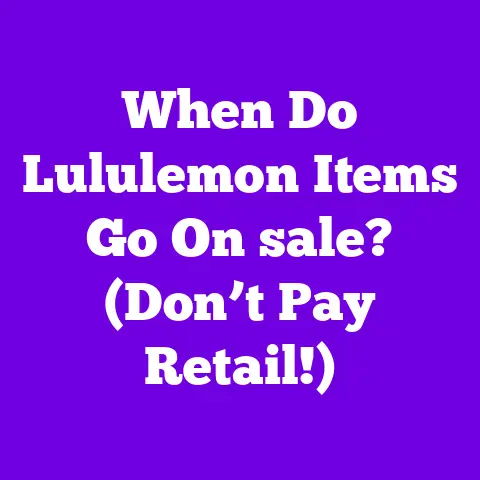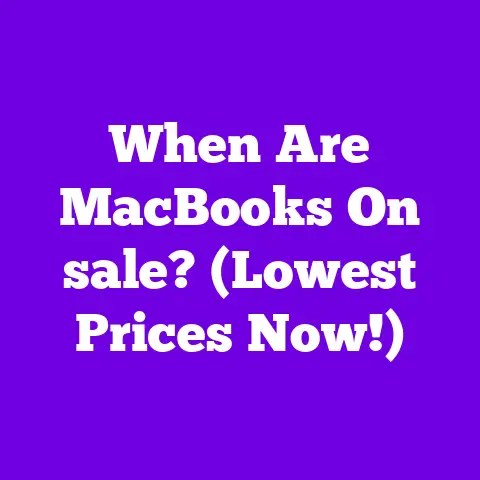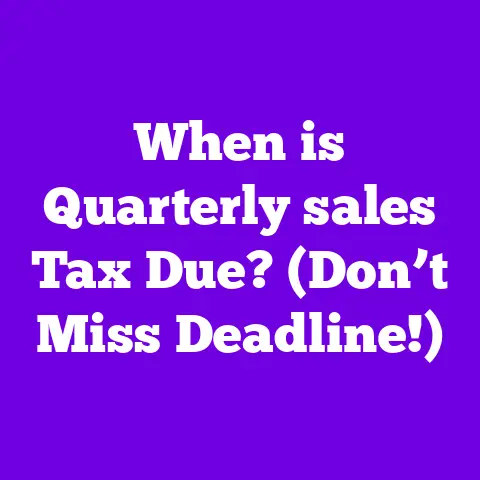How to Know When Stores Have sales (Don’t Miss Flash Deals!)
Have you ever walked into a store, your eyes set on that perfect gadget or stylish outfit you’ve been dreaming about, only to discover that it was on sale yesterday?
The sinking feeling of missing out on a fantastic deal is something I, and I’m sure many of you, have experienced all too often.
It’s frustrating, to say the least.
Imagine the savings you could accumulate if you were always in the know!
This article is your guide to navigating the ever-evolving world of retail sales in 2025 and ensuring you never miss another flash deal again.
I’ll equip you with the knowledge and tools to become a savvy shopper, maximizing your savings and making informed purchasing decisions.
Section 1: Understanding the Sales Landscape
The retail landscape has transformed dramatically, especially with the rise of e-commerce.
Gone are the days when sales were predictable, seasonal events.
Now, retailers are constantly experimenting with flash sales, time-limited offers, and exclusive online deals to capture our attention and drive purchases.
According to a recent report by Statista (https://www.statista.com/statistics/254375/online-retail-sales-worldwide/), global e-commerce sales are projected to reach \$7.4 trillion in 2025.
This staggering number illustrates the massive shift towards online shopping and the increasing importance of digital sales strategies.
This shift has also influenced traditional brick-and-mortar stores, forcing them to adapt and offer more frequent and enticing promotions to compete with online retailers.
The result?
A more dynamic and often unpredictable sales environment.
But why are sales so effective?
It all boils down to psychology.
Retailers leverage the principles of perceived urgency and scarcity to influence our buying behavior.
When we see a “limited-time offer” or a “while supplies last” label, we’re more likely to make a purchase, driven by the fear of missing out (FOMO).
This psychological trigger can often lead to impulsive buying decisions.
Furthermore, the concept of “anchoring” plays a significant role.
Retailers often display the original price alongside the sale price, creating a perception of significant savings.
Even if the sale price is still higher than the item’s actual value, the comparison makes it seem like a great deal.
Understanding these psychological tactics is the first step in becoming a more informed and strategic shopper.
By recognizing these influences, you can make more rational decisions and avoid falling prey to impulsive purchases.
Section 2: Tools and Resources to Track Sales
Fortunately, we live in an age where technology provides us with a plethora of tools and resources to stay informed about sales.
I’ve personally tested many of these, and here are some of my favorites:
- Deal Aggregator Apps and Websites: Platforms like Honey (https://www.joinhoney.com/), Rakuten (https://www.rakuten.com/), and RetailMeNot (https://www.retailmenot.com/) aggregate deals from various retailers and alert you to flash sales.
Honey, for example, automatically searches for and applies coupon codes at checkout, while Rakuten offers cashback on purchases made through their platform. - Store Newsletters: Subscribing to store newsletters is a surprisingly effective way to stay updated on promotions.
Many retailers offer exclusive discounts and early access to sales for their subscribers.
I’ve found that these newsletters often provide valuable information that isn’t readily available elsewhere. - Social Media Following: Following your favorite brands on social media platforms like Instagram, Facebook, and Twitter is crucial.
Retailers often announce flash sales and exclusive offers on these channels, sometimes with limited-time codes that are only shared with their followers. - Mobile Notifications: Most retail apps offer the option to enable mobile notifications.
Setting these up ensures you never miss a deal.
You can customize the notifications to receive alerts only for specific products or brands you’re interested in. - Price Tracking Tools: Services like CamelCamelCamel (https://camelcamelcamel.com/) (for Amazon) allow you to track the price history of specific products and receive alerts when the price drops.
This is particularly useful for big-ticket items like electronics and appliances.
Here’s a table summarizing these tools:
- Black Friday (November): This is the biggest shopping day of the year, offering deep discounts on a wide range of products.
However, be prepared for crowds and limited availability. - Cyber Monday (Following Black Friday): Primarily focused on online deals, Cyber Monday is a great opportunity to snag discounts on electronics, clothing, and other popular items.
- End-of-Season Sales (Various Months): Retailers typically offer significant discounts on seasonal items to clear out inventory and make room for new collections.
For example, summer clothing goes on sale in late summer, and winter clothing goes on sale in late winter. - Back-to-School Sales (July-August): These sales offer discounts on school supplies, clothing, and electronics.
- Holiday Sales (December): In the lead-up to Christmas, retailers offer a variety of promotions to encourage holiday spending.
- Amazon Prime Day (Typically July): Exclusively for Amazon Prime members, this event offers significant discounts on a wide range of products.
Here’s a month-by-month breakdown of when you can generally expect sales from different types of retailers:
Emerging Sales Trends for 2025:
I anticipate that retailers in 2025 will increasingly focus on personalized offers and loyalty programs.
With the rise of data analytics, retailers can now track our shopping habits and preferences with greater accuracy, allowing them to tailor sales and promotions to individual customers.
Furthermore, I expect to see more retailers experimenting with augmented reality (AR) and virtual reality (VR) to enhance the shopping experience and drive sales.
For example, customers may be able to “try on” clothing virtually or visualize furniture in their homes before making a purchase.
Section 4: Building a Personal Sale Tracker
To truly master the art of finding sales, I recommend creating a personalized sale tracker.
This will help you stay organized, prioritize your purchases, and avoid impulsive buying.
- Maintain a Wishlist: Keep a running list of products you intend to buy.
This will help you focus your search and avoid getting sidetracked by tempting offers. - Prioritize Items: Rank your wishlist items based on necessity and price.
This will help you determine which items to prioritize when sales arise. - Set Reminders: Use your phone or calendar to set reminders to check for sales on specific items or during key sale periods.
- Research Pricing: Before making a purchase, research the typical pricing for the item you’re interested in.
This will help you recognize a good deal and avoid falling for inflated discounts. - Engage with Communities: Join online communities or forums where members share timely deal information.
These communities can be a valuable source of insider tips and early access to sales.
You can create a simple spreadsheet or use a dedicated app to track your wishlist, pricing information, and sale reminders.
Here’s a basic template for a sale tracker:
Section 5: Leveraging Social Media and Community Insights
Social media platforms are more than just spaces for sharing photos and updates; they’re also valuable resources for finding sales.
- Brand Announcements: Brands frequently use platforms like Instagram, Twitter, and TikTok to announce flash sales or exclusive offers.
Pay close attention to their posts and stories, as these announcements often disappear quickly. - Online Communities: Joining online communities like Facebook groups and Reddit threads dedicated to deals and discounts can provide real-time information about sales.
Members often share tips, coupon codes, and early access to promotions. - Hashtag Searches: Use relevant hashtags like #sales, #deals, #discount, and #[brandname]sale to discover sales-related content.
- Influencer Recommendations: Many influencers partner with brands to promote sales and offer exclusive discounts to their followers.
Keep an eye out for these collaborations.
When using social media to find sales, be sure to verify the legitimacy of the offers before making a purchase. Look for official brand accounts and trusted sources.
Here are some examples of how brands use social media for sales:
- Instagram: Brands often use Instagram Stories to announce flash sales and offer limited-time discount codes.
- Twitter: Twitter is a great platform for sharing real-time updates on sales and promotions.
- TikTok: Brands are increasingly using TikTok to create engaging videos that showcase their products and announce sales.
- Facebook: Facebook groups dedicated to deals and discounts are a valuable resource for finding sales and connecting with other savvy shoppers.
Conclusion
Missing out on a great deal is a frustrating experience, but with the right tools and strategies, you can become a master shopper and maximize your savings in 2025.
By understanding the sales landscape, utilizing available resources, and creating a personalized sale tracker, you can stay informed and make informed purchasing decisions.
Remember, being proactive is key.
Don’t wait for sales to come to you; actively seek them out.
With a little effort and planning, you can navigate the world of retail sales with confidence and never miss another flash deal again.
Call to Action
I encourage you to implement the strategies discussed in this article and share your experiences with tracking sales in the comments below.
What are your favorite tools and tips for finding deals?
Let’s create a community of savvy shoppers who can help each other save money!






